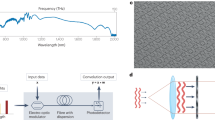Abstract
While numerous artificial neural network (ANN) models have been electronically implemented and simulated by conventional computers, optical technology provides a far superior mechanism for the implementation of large-scale ANNs. The properties of light make it an ideal carrier of data signals. With optics, very large and high speed neural network architectures are possible. Because light is a predictable phenomenon, it can be described mathematically and its behavior can be simulated by conventional computers. A hologram is in essence a capture of the light field at a particular moment in time and space. Later, the hologram can be used to reconstruct the three dimensional light field carrying optical data. This makes a hologram an ideal medium for capturing, storing, and transmitting data in optical computers, such as optical neural networks (ONNs). Holograms can be created using conventional methods, but they can also be computer generated. In this paper, we will present an overview of optical neural networks, with emphasis on the holographic neural networks. We will take a look at the mathematical basis of holography in terms of the Fresnel Zone Plate and how it can be utilized in making computer generated holograms (CGHs). Finally, we will present various methods of CGH implementation in a two layer holographic ONN.
Similar content being viewed by others
Explore related subjects
Discover the latest articles, news and stories from top researchers in related subjects.References
M.R. Feldman, S.C. Esener, C.C. Guest, and S.H. Lee, “Comparison between optical and electrical interconnects based on power and speed consideratons,” Applied Optics, vol. 27, pp. 1742-1751, 1988.
A. Agranat, C.F. Neugebauer, and A. Yariv, “Parallel optoelectronics realization of neural network models using CID technology,” Applied Optics, vol. 27, pp. 4354-4355, 1988.
M. Minsky, The Society of Mind, Simon and Schuster: New York, NY, 1986.
D. Gabor, “A new microscopic principle,” Nature, vol. 166, pp. 777-778, 1948.
E.N. Leith and J. Upatnieks, “Reconstructed wavefronts and communication theory,” Journal of the Optical Society of America, vol. 52, pp. 1123-1130, 1962.
W.E. Kock, Engineering Applications of Lasers and Holography, Plenum Press: New York, 1975.
F.T.S. Yu, “Optical neural networks: Architecture, design and models,” Progress in Optics XXXII, edited by E. Wolf, North-Holland: New York, pp. 61-144, 1993.
P.K. Simpson, “Foundations of neural networks,” Artificial Neural Networks: Paradigms, Applications, and Hardware Implementations, edited by E. S'anchez-Simencio and C. Lau, IEEE Press, pp. 3-24, 1992.
J.J. Hopfield, “Neural networks and physical systems with emergent collective computational ablilities,” in Proc. Nat. Acad. Sci., vol. 79, pp. 2554-2558, 1982.
N.H. Farhat, “Optoelectronic neural networks and learning machines,” IEEE Circuits and Devices Mag., pp. 32-41, 1989.
J.E. Midwinter and D.R. Selviah, “Digital neural networks, matched filters and optical implementations,” Neural Computing Architectures: The Design of Brain-Like Machines, edited by I. Aleksander, North Oxford Academic Publishers Ltd., Great Britain, pp. 258-278, 1989.
K. Hsu, D. Brady, and D. Psaltis, Neural Information Processing Systems, American Institute of Physics: NewYork, pp. 377-386, 1988.
N.H. Farhat, “Optoelectronic analogs of self-programming neural nets: Architecture and methodologies for implementing fast stochastic learning by simulated annealing,” Applied Optics, vol. 26, no. 23, pp. 5093-5103, 1987.
B.H. Soffer, G.J. Dunning, Y. Owechko, and E. Marom, “Associative holographic memory with feedback using phase-conjugate mirrors,” Optics Lett., vol. 11, pp. 118-120, 1986.
N.H. Farhat, D. Psaltis, A. Prata, and E. Paek, “Optical implementation of the Hopfield model,” Applied Optics, vol. 24, no. 10, pp. 1469-1475, 1985.
Y. Ichioka, T. Iwaki, and K. Matsuoka, “Optical information processing and beyond,” in Proc. IEEE, vol. 84, no. 5, pp. 694-719, 1996.
A. Mikaelian, “1-D holographic memory for information processing,” Photonics for Processor, Neural Networks, and Memories II, edited by J.L. Horner, B. Javidi, and S.T. Kowel; in Proc. SPIE, vol. 2297, pp. 155-63, 1994.
W.L. Siemens-Wapniarski and M. Parker Givens, “The Experimental Production of Synthetic Holograms,” Applied Optics, vol. 7, pp. 535-538, 1968.
J.P. Waters, “Holographic image synthesis utilizing theoretical methods,” Applied physics letters, vol. 9, no. 11, pp. 405-407, 1966.
W. Lee, “Computer generated holograms: Techniques and applications,” Progress in Optics XVI, pp. 119-232, 1978.
G.L. Rogers, “Gabor diffraction microscopy: The hologram as a Generalized Zone Plate,” Nature, vol. 166, p. 237, 1950.
T. Poon et al., “Real-time two-dimensional Holographic imaging using an electron-beam-addressed spatial light modulator,” Opt. Lett., vol. 18, pp 63-65, 1993.
N. Hasmoto, S. Morokawa, and K. Kitamura, “Real-time holography using the high-resolution LCTV-SLM.” in Proc. SPIE, vol. 1461, pp. 291-302, 1991.
A. Macovski, “Considerations of television holography,” Optica Acta, vol. 18, pp. 31-39, 1971.
L. Onural, G. Bozdagi, and A. Atalar, “New high-resolution display device for holographic three-dimensional video: Principles and simulations,” Opt. Eng., vol. 33, pp. 835-844, 1994.
T. Poon, M.H. Wu, K. Shinoda, and Y. Suzuki, “Optical scanning holography,” in Proc. IEEE, vol. 84, no. 5, pp. 753-764, 1996.
P.P. Banerjee and T. Poon, Principles of Applied Optics, Irwin, Boston, 1991.
D.G. Feitelson, Optical Computing: A Survey for Computer Scientists, The MIT Press: Cambridge, Massachusetts, pp. 43-315, 1988.
H.M. Smith, Principles of Holography, Wiley-Interscience, John Wiley and Sons, Inc., New York, pp. 32-42, 1969.
J.W. Goodman, in Introduction to Fourier Optics, edited by F.E. Terman, McGraw-Hill, Physical and Quantum Electronics Series, 1968.
K. Kaikhah, Neural Networks Class Notes, Southwest Texas State University, Fall 1995.
Author information
Authors and Affiliations
Rights and permissions
About this article
Cite this article
Kaikhah, K., Loochan, F. Computer Generated Holograms for Optical Neural Networks. Applied Intelligence 14, 145–160 (2001). https://doi.org/10.1023/A:1008314025737
Issue Date:
DOI: https://doi.org/10.1023/A:1008314025737




